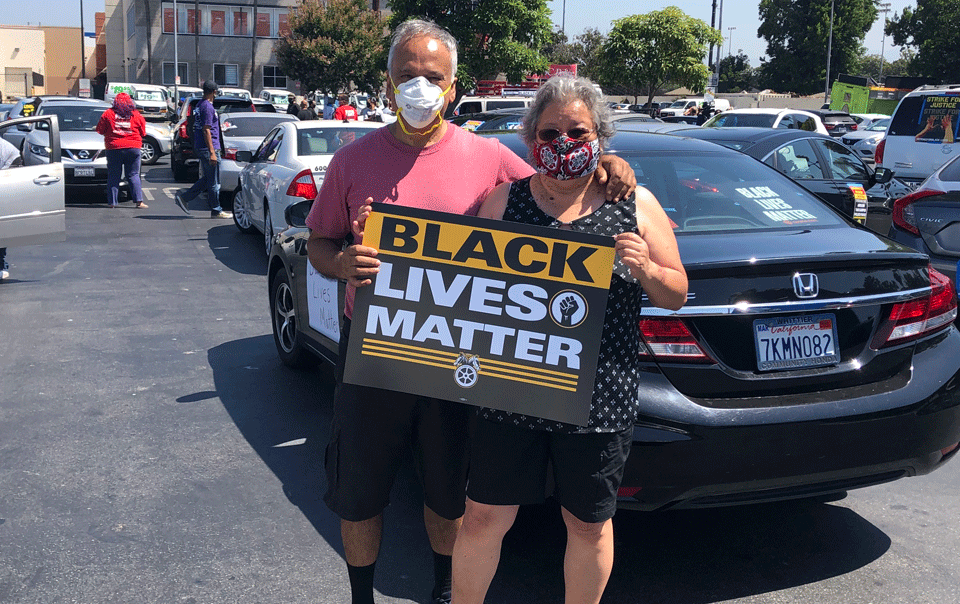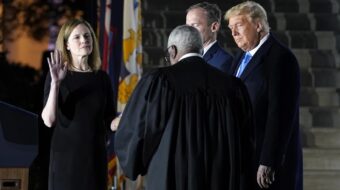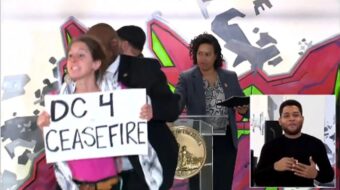
LOS ANGELES – As Rossana Cambron contemplates the multiple crises and threats to democracy facing the nation, the Communist Party USA co-chair is gripped with urgency. But she also sees much to be excited about and the potential for a transformative moment.
“All these social and democratic movements are coming together, there’s a deeper understanding about injustice, especially police brutality against Black people, and growing interest in socialism. And I see an incredible desire for people to get involved,” she said.
Cambron, who resides in Los Angeles, also leads the CPUSA Organization Department. She manages to balance outreach to the burst of new members with protest caravans and voter mobilization to defeat Trump. She took a break to answer some questions from People’s World.
Like everyone, Rossana Cambron’s life and daily routine were upended by the pandemic. “Your perspective changes during times like this. I sense people are more generous, considerate, and acting in solidarity,” she said.
Cambron believes she was infected by the virus early on. “I had a dry cough and heart palpitations with a sensation that something was attacking my lungs. I experienced the loss of taste and smell. I’ve never been sick like that before.”
Rossana and her husband, Arturo, now severely restrict their social circle. This is particularly hard because it means she can’t hold her newborn grandson. “I understand. It’s not about me. It’s about the baby. But logic and the heart don’t work together well. We’re all adapting,” says Rossana with a laugh. Another son and his wife are expecting a baby in January.
After initially containing the COVID-19, California and Los Angeles, in particular, experienced a resurgence. In response, Gov. Gavin Newsom and LA Mayor Eric Garcetti rolled back plans to reopen the economy.
The LA Unified School District, the nation’s second-largest, will start the new school year entirely remotely. People are urged to shelter-in-place, and beaches, bars, and restaurants are shut down again. As a result, the infection rate is holding steady even as hospital beds and ICUs fill up.
Asked what caused the resurgence, Rossana offered a few observations. “People got tired of being at home. They forgot how dangerous the virus is,” she said. “Commentators were saying, ‘enough is enough,’ as if the pandemic wasn’t real. People can’t just think about themselves and forget the consequences.” But awareness, especially among young people, is growing.
Latino community hit hardest
Nationally, about 34% of COVID-19 infections are in the Latino community. In California, Latinos make up 56% of cases, and 45% of deaths. Cambron sees several reasons for this, beginning with systemic racism in all aspects of life, work, and the public health system.
“Many Latino workers don’t have the luxury of working from home,” she said. They are among the essential workers in agriculture, meat processing plants, warehouses, garment, and other industries where hotspots have occurred.
“Just take vendors, they can’t sell their food or tamales or anything they sell via zoom. They have to go out to provide for their families. They are at high risk,” she said.
Many people in the Latino community use public transportation. “They have to go to work and don’t have money to buy a car. Undocumented immigrant workers won’t get licenses because they don’t trust DMV and worry about getting stopped. This exposes them to the virus.”
Many undocumented immigrants lack access to adequate health care. Cambron recounted the story of a friend who works as a nurse at a community clinic serving undocumented immigrants with minor health issues.
“The minute they said something about the outbreak, the clinic was packed,” she said. “The clinics are free or low cost, but immigrants won’t go to the hospital or ER because they can’t afford it. They’ll turn to home remedies.”
Multiple Latino families live in one house, making social distancing virtually impossible. And family members working outside the house risk exposing relatives if they bring the virus home.
And some immigrant workers without families rent a room with another family. “They’ll rent half a room because rent is so high. So, if someone else is sick they have a higher chance of getting it,” she said.
Due to high rents and an affordable housing shortage, 66,000 people were homeless in Los Angeles last year, a 14% increase. Of the homeless population, 35% are Latino, and 34% are African American. Again, many immigrants are fearful of accessing services because of their immigration status.
Homelessness could increase dramatically if the national moratorium on evictions is lifted. Moreover, many undocumented immigrants are denied federal assistance and are particularly vulnerable.
The state and city have a patchwork of programs to help undocumented immigrants. One program dispenses $500 to laid-off workers, but this is not enough. Besides, there are many food pantries, mutual aid groups, and the LA County Federation of Labor is distributing food.
The Latino population is overall younger, and this age group is experiencing the most significant increase in infections. “At first, especially young people were dismissive. In Orange County, the right wingers are adamant the restrictions are an infringement on their rights,” she said.
“[Mexican Americans] are such a close-knit community. Our culture is about recognizing each other’s presence, which means first and foremost a hug, a handshake, or some form of touching,” said Cambron. “That’s very difficult to do when we’re asked to social distance. It’s really awkward. If you don’t do it, you feel like you’re disrespecting people.”
Cambron says the only solution to the pandemic is restarting the process and following the guidance of scientists and public health officials. This seems unlikely with Trump in the White House.
Rights reaffirmed
According to Cambron, the U.S. Supreme Court ruling, which returned three million acres of eastern Oklahoma to the Muscogee Creek Nation (MCN), reaffirmed Indigenous treaty rights. The earthshaking decision holds special meaning for Cambron because she traces nearly half her ancestry to the Zacatecos and Huichol Indigenous peoples in Central Mexico.
“Up until a few years ago, I had never explored the Indigenous side of me. I was all about my Mexican ancestry,” Rossana said. “This was part of a colonization mindset that doesn’t allow you to recognize these kinds of things. It’s really important to know where you come from.”
Cambron and her daughter have matching tattoos of an image combining the four elements, Earth, water, air, and fire, and the Noche Buena or Poinsettia flower. The illustration is based on an embroidery her mother taught her as a child.
“The SCOTUS decision has wide ramifications that go beyond the criminal cases that surround the issue. For Indigenous people, it means recognition and hope you can win these battles. Even though it’s been hundreds of years, these treaties need to be dealt with.”

Cambron said this victory is connected to the Black Lives Matter uprising. Millions are gaining a deeper understanding of racial injustices against African Americans, Indigenous, Latinos, Asians, and other oppressed peoples. The real history of the country and the intersection of slavery, the genocide of Indigenous peoples, and the theft of lands from Mexico, is becoming clear to millions.
“Overall, the BLM protests have positively impacted Indigenous and Latino communities. Latinos and African Americans have faced threats of division and being pitted against each other. But people are saying, ‘we’re not going to be divided.’”
The uprising has boosted the unity of all the racially oppressed communities and movements. Cambron noted the July 20 “Strike for Black Lives” brought together McDonald’s workers, garment workers, and immigrant struggles under the banner of Black lives.
“Great! People are seeing it as their struggle as well, and ‘an injustice to one is an injustice to all,’” she said.
“As Rev. Martin Luther King, Jr. said, ‘Our lives begin to end the day we become silent about things that matter,’” Cambron said. “This moment calls for everyone to do something, don’t be silent.”
She knows some have hesitations about the Biden campaign. “This is a strategic action to remove Trump. The moment calls upon us to look beyond ourselves and do what’s best for all of us. This is why we need a massive voter turnout in November, a victory margin so undeniable it cannot be contested.”
All that’s going on, including the rapid growth in the CPUSA, gives Rossana Cambron a lot of hope, even though she can’t hold her grandbaby. At least not for the time being.












Comments